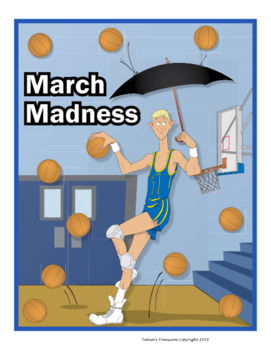March Madness
Tatum's Treasures
2 Followers
Grade Levels
5th - 7th
Subjects
Resource Type
Standards
CCSS5.MD.C.5a
CCSS5.NBT.B.5
CCSS5.NBT.B.6
CCSS5.NBT.B.7
CCSS5.OA.A.2
Formats Included
- Zip
Pages
37 pages
Tatum's Treasures
2 Followers
Description
Let your students join in the excitement of March Madness by completing any or all of these activities. These activities were used in a regular classroom, a math intervention class, and a math enrichment class.
- "Let the Madness Begin" is an introductory activity that provides background for students.
- "Location Location Location" is a mapping activity.
- "My Hometown" requires students to work cooperatively to gather and analyze data.
- The Road to the Final Four" is grade specific. There are 5 worksheets per grade level that review math skills and concepts.
- "Sweet 16 Week" is a fun activity in which students will work cooperatively determining travel expenses for the regional teams' fans.
Total Pages
37 pages
Answer Key
Included
Teaching Duration
2 Weeks
Report this resource to TPT
Reported resources will be reviewed by our team. Report this resource to let us know if this resource violates TPT’s content guidelines.
Standards
to see state-specific standards (only available in the US).
CCSS5.MD.C.5a
Find the volume of a right rectangular prism with whole-number side lengths by packing it with unit cubes, and show that the volume is the same as would be found by multiplying the edge lengths, equivalently by multiplying the height by the area of the base. Represent threefold whole-number products as volumes, e.g., to represent the associative property of multiplication.
CCSS5.NBT.B.5
Fluently multiply multi-digit whole numbers using the standard algorithm.
CCSS5.NBT.B.6
Find whole-number quotients of whole numbers with up to four-digit dividends and two-digit divisors, using strategies based on place value, the properties of operations, and/or the relationship between multiplication and division. Illustrate and explain the calculation by using equations, rectangular arrays, and/or area models.
CCSS5.NBT.B.7
Add, subtract, multiply, and divide decimals to hundredths, using concrete models or drawings and strategies based on place value, properties of operations, and/or the relationship between addition and subtraction; relate the strategy to a written method and explain the reasoning used.
CCSS5.OA.A.2
Write simple expressions that record calculations with numbers, and interpret numerical expressions without evaluating them. For example, express the calculation “add 8 and 7, then multiply by 2” as 2 × (8 + 7). Recognize that 3 × (18932 + 921) is three times as large as 18932 + 921, without having to calculate the indicated sum or product.





